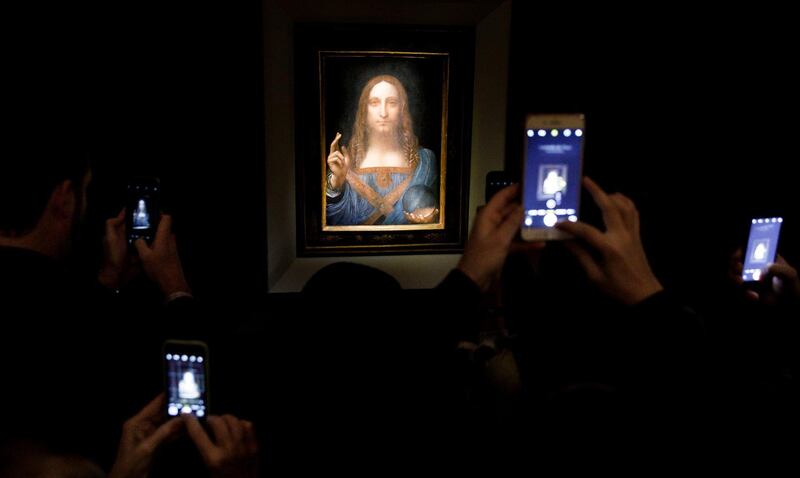The record-breaking sale of Leonardo da Vinci's oil painting Salvator Mundi to the Abu Dhabi Government last year was a coup not just for the buyer – whose identity remained secret for almost a month – but for the auction house who sold it.
Christie's today announced a 21 per cent year-on-year increase in global sales in 2017 to $6.6 billion led by the sale of the 500-year-old painting which went under the hammer in New York in November for a staggering $450 million.
The final price was more than four times the painting’s pre-sale estimate and made it the most expensive work of art ever sold at auction. It will go on display at the newly opened Louvre Abu Dhabi and is expected to draw crowds from across the world.
However, Michael Jeha, the managing director of Christie’s Middle East, insists that even without the Da Vinci, “2017 was an extremely strong year” for the British art dealer.
"We sold seven of the top 10 most expensive artworks around the world; took the leading market share for every key category of art, from post-war to contemporary to decorative, and we achieved an 81 per cent average selling percentage at our auctions, which is an exceptional figure," he tells The National at Christie's office in Dubai.
“We’re expecting another strong year in 2018,” he adds. “There won’t be another Leonardo, but there will be other things.”
Christie’s reported that sales in Europe and the Middle East totalled $2bn in 2017, up 11 per cent from the previous year. The figure includes sales to Middle East-based buyers as well as sales originating from the Middle East. Christie’s does not provide a breakdown just for the Middle East, but Mr Jeha says it is an increasingly mature art market.
“Overall, 2017 was a very strong year for the Middle East and it’s a very important market for us,” he says. “We’re seeing demand grow in the region and increasing participation by Middle Eastern clients at Christie’s globally.
“They’re not just buying Middle Eastern art – their tastes are internationalising and they’re starting to branch out into other categories, such as global contemporary art.”
Last year, Christie’s opted to permanently ditch its second annual Dubai auction programme, usually held in October, as part of a strategy to “internationalise” the Middle East market. From now on, just one series of auctions will be held in Dubai each year, in March alongside Dubai Art Week. Last year’s October auction was moved to London and generated £5m (Dh26.1m) of sales, Mr Jeha says.
“The purpose of holding auctions here in Dubai is to engage clients from the Middle East for the first time, so Dubai is a platform to encourage those buyers to participate at Christie’s globally.
_____________
Read more:
Rare pink diamond sells for $32m
Christie's Auction House launches online courses for art enthusiasts
Leonardo da Vinci's Salvator Mundi painting up for auction with $100 million estimate
_____________
“After 11 years, we’re seeing increasing international participation in Middle Eastern art and the next logical step was to hold Middle East auctions in London to internationalise further.”
Segments in which Middle East buyers are particularly active include Islamic, decorative and contemporary arts, but the luxury sector – including watches, jewellery and handbags – is at least as important for regional buyers. In particular, watch auctions are growing “tremendously”, Mr Jeha says. Five years ago, the first watch auction in Dubai raised around $800,000; the last one in March 2017 generated over $5m of sales.
Christie’s says it is seeing increasing participation in the global art market by Emiratis, as well as by Iranians, Lebanese, Turks, Qataris and European expats living in the region. In 2018, the auction house has a number of upcoming initiatives set to lure them some more. In particular, the art collection of US philanthropists Peggy and David Rockefeller will go on sale in New York in May. “We expect that auction will generate significant interest among Middle Eastern collectors,” Mr Jeha says.
“Not only is the calibre of the collection extremely high, but the Rockefellers have strong links to the Middle East, having supported it through education and excavation activities.”
Another initiative expected to appeal to Middle East art enthusiasts is Christie’s programme of online art education courses, which are now available in Arabic. Christie’s will also be running a series of events, client dinners, charity auctions and panel discussions across the region throughout the year, while Dubai’s programme of auctions in March is “extremely strong”, the managing director says.
The art world is often viewed as elitist by some, but Mr Jeha says this does not have to be the case. In 2017, almost a third (31 per cent) of new buyers globally were new to Christie’s, the auction house says, suggesting that the market is becoming more accessible. This is partly driven by an 8 per cent rise in online sales, to $72.5m over the previous year. In the digitally connected and youthful Middle East, online auctions are expected to play a big role in facilitating sales in the future. “Online is becoming an increasingly important platform to engage with collectors, particularly young collectors,” Mr Jeha says.
The opening of the Louvre Abu Dhabi is a game-changer, he adds. “I think it will make a big impact on the region’s art scene in the long term, by inspiring future generations of artists, art enthusiasts and collectors.
“Kids growing up here will visit the museum as part of their education, and that is very exciting. The future of the art scene in the Middle East is very bright.”





